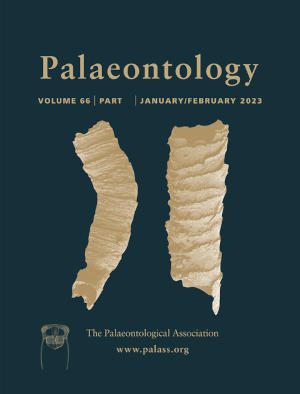Article: Vital statistics, absolute abundance and preservation rate of Tyrannosaurus rex
Publication: Palaeontology
Volume:
66
Part:
2
Publication Date:
2023
Article number:
e12648
Author(s):
Eva M. Griebeler
Abstract
Abstract I present a simulation model on vital statistics, absolute abundance (N, total number of individuals that ever lived) and preservation rate (p, minimum number of fossils known divided by N) of Tyrannosaurus rex. It is based on a published age-structured population model that assumes a reptile or bird-like reproduction for T. rex to estimate its age-specific survival rates. My model applies input variables and equations from a recently published model on N and p. This model yielded 2.5 billion T. rex individuals (N) and one fossil per 80 million individuals (p). The average N values calculated by my model were at minimum 27.6% and p values at maximum 361.5% that of a previous model and uncertainties in all output variables were always larger in my model. The equation on output variable ‘population density’ introduced the largest uncertainty to N and p. The output variable ‘generation time’ differed the most between models, but for N and p, the huge size of the input area modelled and geological longevity minimized this difference. Unlike my model, the generation time as well as life expectancies, gross reproduction rates, and reproductive values of individuals calculated from the previous model all strongly contradicted our current understanding of the biology of T. rex and of other theropods. Their values also disagreed with those of large extant reptiles, birds and mammals. All of these shortcomings of the previous model favour the assessment of individual and population characteristics of T. rex and of other extinct species using my model.
